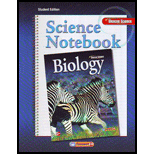
Concept explainers
To sequence:
The steps that occur in the water vascular system to enable an echinoderm to move by completing the given flow chart.
Introduction: Animals belonging to the phylum Echinodermata have unusual characteristics that distinguish them from animals of other phyla. These animals are found in all the oceans of the world. They move by means of hundreds of hydraulic, suction- cup- tipped appendages and have skin covered with tiny pincers.
Answer to Problem 6MI

Explanation of Solution
An important feature of all echinoderms is their water vascular system- systems of fluid- filled closed tubes that work together enable echinoderms to move and get food. There is a strainer like opening to the water vascular system known as a madreporite. Water is drawn into the madreporite, and then moves through the stone canal to the ring canal. From there water moves to the radial canals and finally to the tube feet.
Tube feet are small, muscular fluid filled tube that ends in suction- cuplike structure and is used for movement, food collection and respiration. The opposite end of the tube feet is a muscular sac called the ampulla. When the muscles contract in the ampulla water is forced out into the tube feet and it extends. The suction cup- like structure on the end of the tube feet attaches it to the surface. This hydraulic suction enables all echinoderms to move.
Hence the correct sequence of steps is:
C-> B->F-> D-> A-> E
Additional Science Textbook Solutions
Biological Science
Essentials of Genetics (9th Edition) - Standalone book
Fundamentals of Anatomy & Physiology Plus Mastering A&P with eText - Access Card Package (10th Edition) (New A&P Titles by Ric Martini and Judi Nath)
Brock Biology of Microorganisms (15th Edition)
Campbell Biology (11th Edition)
Becker's World of the Cell (9th Edition)
 Human Anatomy & Physiology (11th Edition)BiologyISBN:9780134580999Author:Elaine N. Marieb, Katja N. HoehnPublisher:PEARSON
Human Anatomy & Physiology (11th Edition)BiologyISBN:9780134580999Author:Elaine N. Marieb, Katja N. HoehnPublisher:PEARSON Biology 2eBiologyISBN:9781947172517Author:Matthew Douglas, Jung Choi, Mary Ann ClarkPublisher:OpenStax
Biology 2eBiologyISBN:9781947172517Author:Matthew Douglas, Jung Choi, Mary Ann ClarkPublisher:OpenStax Anatomy & PhysiologyBiologyISBN:9781259398629Author:McKinley, Michael P., O'loughlin, Valerie Dean, Bidle, Theresa StouterPublisher:Mcgraw Hill Education,
Anatomy & PhysiologyBiologyISBN:9781259398629Author:McKinley, Michael P., O'loughlin, Valerie Dean, Bidle, Theresa StouterPublisher:Mcgraw Hill Education, Molecular Biology of the Cell (Sixth Edition)BiologyISBN:9780815344322Author:Bruce Alberts, Alexander D. Johnson, Julian Lewis, David Morgan, Martin Raff, Keith Roberts, Peter WalterPublisher:W. W. Norton & Company
Molecular Biology of the Cell (Sixth Edition)BiologyISBN:9780815344322Author:Bruce Alberts, Alexander D. Johnson, Julian Lewis, David Morgan, Martin Raff, Keith Roberts, Peter WalterPublisher:W. W. Norton & Company Laboratory Manual For Human Anatomy & PhysiologyBiologyISBN:9781260159363Author:Martin, Terry R., Prentice-craver, CynthiaPublisher:McGraw-Hill Publishing Co.
Laboratory Manual For Human Anatomy & PhysiologyBiologyISBN:9781260159363Author:Martin, Terry R., Prentice-craver, CynthiaPublisher:McGraw-Hill Publishing Co. Inquiry Into Life (16th Edition)BiologyISBN:9781260231700Author:Sylvia S. Mader, Michael WindelspechtPublisher:McGraw Hill Education
Inquiry Into Life (16th Edition)BiologyISBN:9781260231700Author:Sylvia S. Mader, Michael WindelspechtPublisher:McGraw Hill Education





